Please sign in first
Not a member?
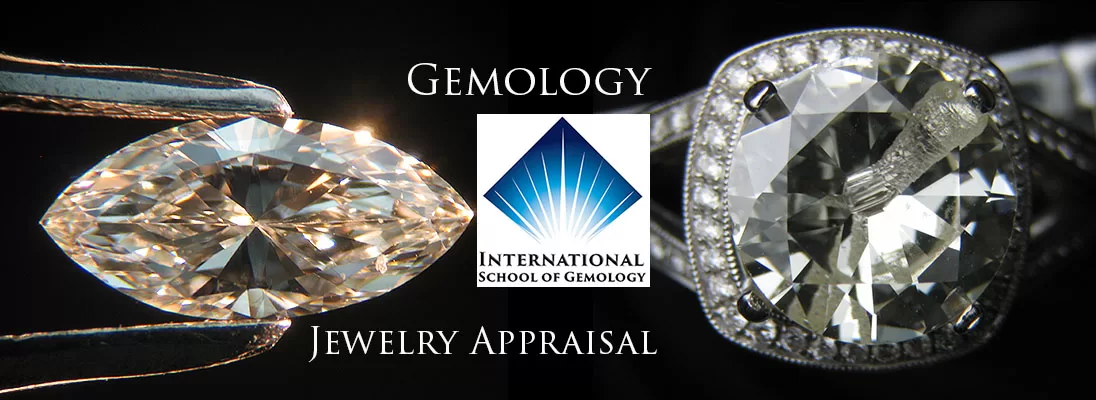
- Home
- Online Education Programs
- RG/RGA Legacy Entrance
- ISG Credentials
- Frequently Asked Questions
- Registry of Graduates
- Careers in Gemology
- Important Program Information
- Newsletters
- Identifying Lab Created Diamonds
- Black Diamond or Created Moissanite?
- Ebay, the GIA, and Section 230
- Lessons From the Angry Janitor
- Exposing the Truth about Lab-Created Diamonds
- AGTA Hobbles Dealers and Buyers
- Appraisers -v- Gem Labs…a Legal Imbalance!
- Understanding the Classification of Diamonds
- Cremation Diamonds: Insuring and Litigating
- Let’s Talk About Gemology Credentials
- Hometown Jewelers and the Force Majeure Clause
- Following the Critical Angle of Diamond Grading
- When Breitling Brought the Airmen Home
- Let’s Open a Refractometer
- Measuring the Energy of Light
- Quick Reference Guide to Sunstone
- ISG Seeing the Invisible Light
- Contact Us
How Tanzanite Creates Rare and Beautiful Colors
How Tanzanite Creates Rare and Beautiful Colors
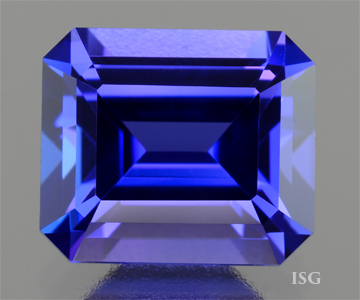 Tanzanite. It is only found in one place on earth. It is reported by several sources to be 1000 times rarer than diamonds. Its story is one of beauty, romance, passion, and even tragedy. And it has optical properties of color that are truly unique and make it one of the most beautiful and sought-after gemstones in the world. The question is: How does tanzanite create its rare and beautiful colors?
Tanzanite. It is only found in one place on earth. It is reported by several sources to be 1000 times rarer than diamonds. Its story is one of beauty, romance, passion, and even tragedy. And it has optical properties of color that are truly unique and make it one of the most beautiful and sought-after gemstones in the world. The question is: How does tanzanite create its rare and beautiful colors?
 Tanzanite formed in a large pegmatite dike in the Merelani Hills of Tanzania. When mined, the stones are generally reddish brown in color and must be heated to bring out the beautiful purple/blue colors for which it is famous. But the question once again is: How does tanzanite create that rare combination of blue and purple that we can see at the same time?
Tanzanite formed in a large pegmatite dike in the Merelani Hills of Tanzania. When mined, the stones are generally reddish brown in color and must be heated to bring out the beautiful purple/blue colors for which it is famous. But the question once again is: How does tanzanite create that rare combination of blue and purple that we can see at the same time?
Like the gemstone, the answer is both simple and amazing at the same time.
 Tanzanite is biaxial in crystal structure, which gives it the property of dichroism. It is actually trichroic but we will talk more about that in another newsletter. Dichroic gemstones take ambient light and produce two colors. As gemologists, we utilize this property in gemstones to make identifications with a dichroscope. A dichroscope allows us to optically separate the colors produced by a gemstone to make them visible individually. This optical property is quite rare in the world of gemstones, particularly to the level attained by tanzanite and another gemstone: Oregon Sunstone.
Tanzanite is biaxial in crystal structure, which gives it the property of dichroism. It is actually trichroic but we will talk more about that in another newsletter. Dichroic gemstones take ambient light and produce two colors. As gemologists, we utilize this property in gemstones to make identifications with a dichroscope. A dichroscope allows us to optically separate the colors produced by a gemstone to make them visible individually. This optical property is quite rare in the world of gemstones, particularly to the level attained by tanzanite and another gemstone: Oregon Sunstone.
 At left are three slides showing an Oregon Sunstone through a London Dichroscope. This consists of two polarizing filters oriented at 90 degrees to each other. It allows us to view the two very dramatic colors that Oregon Sunstone produces at the same time, but our eyes cannot clearly separate the colors without the aid of the polarizing filters.
At left are three slides showing an Oregon Sunstone through a London Dichroscope. This consists of two polarizing filters oriented at 90 degrees to each other. It allows us to view the two very dramatic colors that Oregon Sunstone produces at the same time, but our eyes cannot clearly separate the colors without the aid of the polarizing filters.
Tanzanite works in the same way. But this really does not answer our question: How does tanzanite produce two colors at the same time?
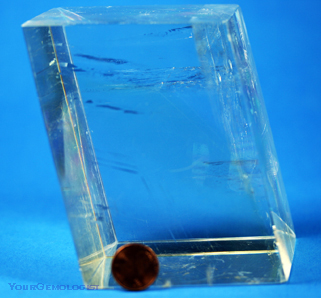 For this we turn to a huge calcite crystal in the ISG Student Reference Collection. Calcite has a very unique property of birefringence. This is defined by the ScienceDirect website as:
For this we turn to a huge calcite crystal in the ISG Student Reference Collection. Calcite has a very unique property of birefringence. This is defined by the ScienceDirect website as:
“Birefringence is the phenomenon exhibited by certain materials in which an incident ray of light is split into two rays, called an ordinary ray and an extraordinary ray…” sciencedirect.com
As seen below, when we direct a single laser beam into our calcite crystal, it splits the beam into two distinct laser beams. These two images are of the same laser in our calcite crystal, photographed in light and dark conditions to view the actual laser beams traveling through the calcite crystal.
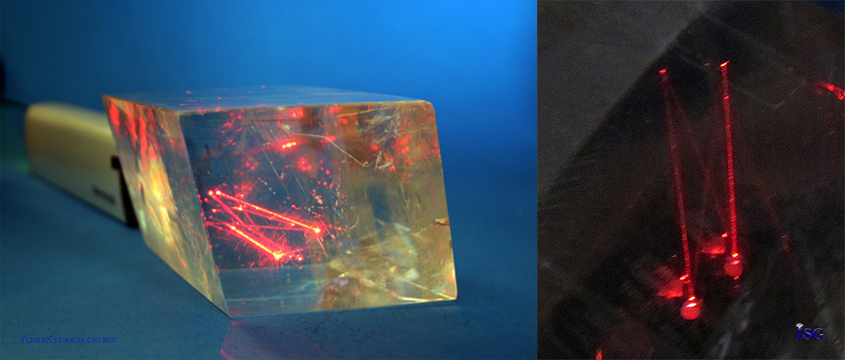
Gemstones use this same property to split a beam of light entering the stone into two beams, but in the case of colored gemstones these two beams of light each produce two different colors. Tanzanite splits the ambient light rays into two beams each creating the separate colors of blue and purple. But can we see this same demonstration with tanzanite as we saw with our calcite crystal? The answer is yes!
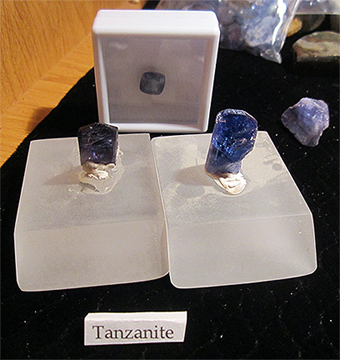 Here are two natural tanzanite crystals. We will take one of these and direct our laser beam into it to see how this tanzanite can split the laser into two beams.
Here are two natural tanzanite crystals. We will take one of these and direct our laser beam into it to see how this tanzanite can split the laser into two beams.
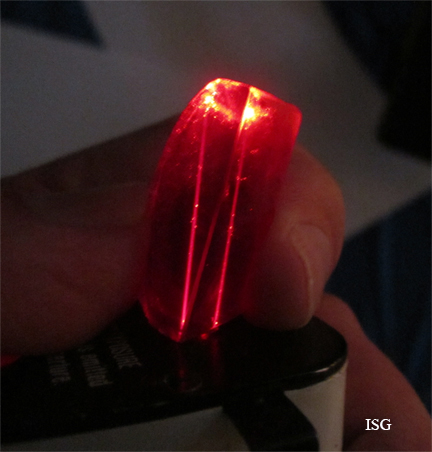 And here is the result that clearly shows this single laser beam being directed into our tanzanite crystal and splitting into two very distinct beams. If we were able to see an ambient light ray entering the stone in real life, we would see these two beams with one in blue and one purple. Of course, lasers cannot demonstrate that, but again…the dichroscope is the next best thing to use for identification of tanzanite.
And here is the result that clearly shows this single laser beam being directed into our tanzanite crystal and splitting into two very distinct beams. If we were able to see an ambient light ray entering the stone in real life, we would see these two beams with one in blue and one purple. Of course, lasers cannot demonstrate that, but again…the dichroscope is the next best thing to use for identification of tanzanite.
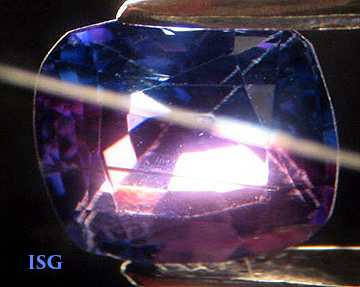 Finally our tanzanite through a London Dichroscope showing the amazing blue and purple colors that make it so famous and desirable.
Finally our tanzanite through a London Dichroscope showing the amazing blue and purple colors that make it so famous and desirable.
The study of gemology is not rocket science and should not cost tens of thousands of dollars. Gemology is a fun study of how nature works around us. How crystals grow. How light interacts with those crystals. How we can use simple concepts with simple tools to identify these amazing gifts of nature we call gemstones. Gemology should be romantic and fun, not a burden of time and money.
We invite you to join us on this amazing journey called gemology. As a former Allied Teaching Centre of the Gemmological Association of Great Britain, we provide the romantic and fun study, but at a fraction of the cost of any other program in the world.